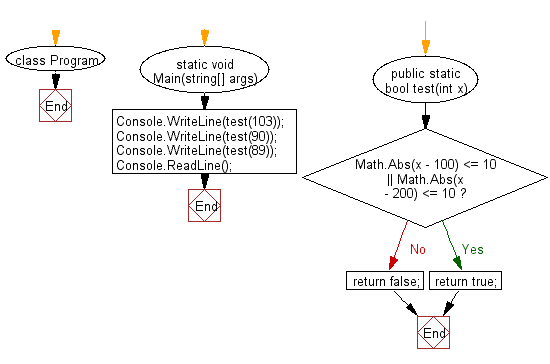C#: Check a given integer and return true if it is within 10 of 100 or 200
Within 10 of 100 or 200
Write a C# Sharp program to check a given integer and return true if it is within 10 of 100 or 200.
Sample Solution:
C# Sharp Code:
using System;
// Namespace declaration
namespace exercises
{
// Class declaration
class Program
{
// Main method - entry point of the program
static void Main(string[] args)
{
// Calling the 'test' method and displaying the returned boolean values
Console.WriteLine(test(103)); // Output: True
Console.WriteLine(test(90)); // Output: True
Console.WriteLine(test(89)); // Output: False
Console.ReadLine(); // Keeping the console window open
}
// Method to check if a given integer is within 10 units of 100 or 200
public static bool test(int x)
{
// Checking if the absolute difference between 'x' and 100 is less than or equal to 10,
// OR the absolute difference between 'x' and 200 is less than or equal to 10.
// If either condition is true, returns true; otherwise, returns false.
if (Math.Abs(x - 100) <= 10 || Math.Abs(x - 200) <= 10)
return true;
return false;
}
}
}
Sample Output:
True True False
Flowchart:

For more Practice: Solve these Related Problems:
- Write a C# program to return true if a given integer is within 20 of 300 or 500.
- Write a C# program to check if a number is within 5 units of 50 or 150, exclusive.
- Write a C# program that returns true if the absolute distance from 100 or 200 is divisible by 10.
- Write a C# program to return true if a number lies within 10% of either 100 or 200.
Go to:
PREV : Check 30 or Sum Equals 30.
NEXT : Add 'if' to String if Absent.
C# Sharp Code Editor:
Improve this sample solution and post your code through Disqus
What is the difficulty level of this exercise?
Test your Programming skills with w3resource's quiz.
